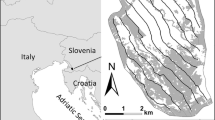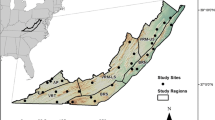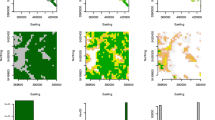Abstract
Large mammalian herbivores are keystone species in different ecosystems. To mediate the effects of large mammalian herbivores on ecosystems, it is crucial to understand their habitat selection pattern. At finer scales, herbivore patch selection depends strongly on plant community traits and therefore its understanding is constrained by patch definition criteria. Our aim was to assess which criteria for patch definition best explained use of meadows by wild, free-ranging, red deer (Cervus elaphus) in a study area in Northeast Portugal. We used two clustering criteria types based on floristic composition and gross forage classes, respectively. For the floristic criteria, phytosociological approach was used to classify plant communities, and its objectivity evaluated with a mathematical clustering of the floristic relevés. Cover of dominant plant species was tested as a proxy for the phytosociological method. For the gross forage classes, the graminoids/forbs ratio and the percentage cover of legumes were used. For assessing deer relative use of meadows we used faecal accumulation rates. Patches clustered according to floristic classification better explained selection of patches by deer. Plant community classifications based on phytosociology, or proxies of this, used for characterizing meadow patches resulted useful to understand herbivore selection pattern at fine scales and thus potentially suitable to assist wildlife management decisions.


Similar content being viewed by others
References
Aguiar CFG (2001) Flora e vegetação da Serra de Nogueira e do Parque Natural de Montesinho. PhD Thesis, Technical University of Lisbon
Arsenault V, Owen-Smith N (2002) Facilitation versus competition in grazing herbivore assemblages. Oikos 97:313–318
Bailey DW, Gross J, Laca E, Rittenhouse L, Coughenour M, Swift D, Sims P (1996) Mechanisms that result in large herbivore grazing distribution patterns. J Range Manag 49:386–400
Bowyer RT, Kie JG (2006) Effects of scale on interpreting life–history characteristics of ungulates and carnivores. Divers Distrib 12(3):244–257
Braun-Blanquet J (1932) Plant sociology—the study of plant communities. McGraw-Hill, New York
Bugalho MN, Milne JA (2003) The composition of the diet of red deer (Cervus elaphus) in a Mediterranean environment: a case of summer nutritional constraint? For Ecol Manag 181(1–2):23–29
Bugalho MN, Lecomte X, Gonçalves M, Caldeira MC, Branco M (2011) Establishing grazing and grazing-excluded patches increases plant and invertebrate diversity in a Mediterranean oak woodland. For Ecol Manag 261(11):2133–2139
Campbell D, Swanson GM, Sales J (2004) Comparing the precision and cost-effectiveness of faecal pellet group count methods. J Appl Ecol 41(6):1185–1196
Chapman DF, Parsons AJ, Cosgrove GP, Barker DJ, Marotti DM, Venning KJ, Rutter SM, Hill J, Thompson AN (2007) Impacts of spatial patterns in pasture on animal grazing behavior, intake, and performance. Crop Sci 47(1):399–415
Clauss M, Kaiser T, Hummel J (2007) The morphophysiological adaptations of browsing and grazing mammals. In: Gordon P (ed) The ecology of browsing and grazing. Springer, Berlin, pp 47–88
Clutton-Brock TH, Guinness FE, Albon SD (1982) Red deer behavior and ecology of two sexes. The University of Chicago Press, Chicago
Cote SD, Rooney TP, Tremblay J-P, Dussault C, Waller DM (2004) Ecological impacts of deer overabundance. Annu Rev Ecol Evol Syst 35(1):113–147
Coulon A, Morellet N, Goulard M, Cargnelutti B, Angibault J-M, Hewison A (2008) Inferring the effects of landscape structure on roe deer (Capreolus capreolus) movements using a step selection function. Landsc Ecol 23(5):603–614
Dufrêne M, Legendre P (1997) Species assemblages and indicator species: the need for a flexible asymmetrical approach. Ecol Monogr 67(3):345–366
Dumont B, Carrère P, D’Hour P (2002) Foraging in patchy grasslands: diet selection by sheep and cattle is affected by the abundance and spatial distribution of preferred species. Anim Res 51(5):367–381
Dumont B, Renaud PC, Morellet N, Mallet C, Anglard F, Verheyden-Tixier H (2005) Seasonal variations of red deer selectivity on a mixed forest edge. Anim Res 54(5):369–381
European Commission (2007) Interpretation manual of European Union Habitats—EUR 27. European Commission DG Environment
Fales SL, Fritz JO (2007) Factors affecting forage quality. In: Barnes RF, Miller DA, Nelson CJ (eds) Forages: the Science of Grassland Agriculture. Blackwell Publishing, pp 569–580
Fisher RA (1935) The logic of inductive inference. J R Stat Soc 98:39–82
Fisher RA (1990) Statistical methods, experimental design, and scientific inference: a re-issue of statistical methods for research workers, the design of experiments, and statistical methods and scientific inference. Oxford University Press, USA
Fortin D, Beyer HL, Boyce MS, Smith DW, Duchesne T, Mao JS (2005) Wolves influence elk movements: behavior shapes a trophic cascade in Yellowstone National Park. Ecol 86(5):1320–1330
García A (1992) Conserving the species-rich meadows of Europe. Agric Ecosyst Environ 40:219–232
Gordon IJ (1988) Facilitation of red deer grazing by cattle and its impact on red deer performance. J Appl Ecol 25(1):1–9
Gordon IJ (1989a) Vegetation community selection by ungulates on the Isle of Rhum. I. Food supply. J Appl Ecol 26(1):35–51
Gordon IJ (1989b) Vegetation community selection by ungulates on the Isle of Rhum. II. Vegetation community selection. J Appl Ecol 26(1):53–64
Griffiths WM, Hodgson J, Arnold GC (2003) The influence of sward canopy structure on foraging decisions by grazing cattle. I. patch selection. Grass Forage Sci 58:112–124
Gu W, Swihart RK (2004) Absent or undetected? Effects of non-detection of species occurrence on wildlife-habitat models. Biol Conserv 116(2):195–203
Hanley TA (1997) A nutritional view of understanding and complexity in the problem of diet selection by deer (cervidae). Oikos 79(2):209–218
Hartigan JA, Wong MA (1979) Algorithm AS 136: a k-means clustering algorithm. J R Stat Soc Ser C Appl Stat 28(1):100–108
Hebblewhite M, Merrill EH, McDonald TL (2005) Spatial decomposition of predation risk using resource selection functions: an example in a wolf–elk predator–prey system. Oikos 111(1):101–111
Huntly N (1991) Herbivores and the dynamics of communities and ecosystems. Annu Rev Ecol Syst 22:477–503
Jacobs J (1974) Quantitative measurement of food selection: a modification of the forage ratio and Ivlev’s electivity index. Oecologia 14(4):413–417
Johnson C, Parker K, Heard D (2001) Foraging across a variable landscape: behavioral decisions made by woodland caribou at multiple spatial scales. Oecologia 127(4):590–602
Kie JG, Bowyer RT, Nicholson MC, Boroski BB, Loft ER (2002) Landscape heterogeneity at differing scales: effects on spatial distribution of mule deer. Ecol 83(2):530–544
Kie JG, Ager AA, Bowyer RT (2005) Landscape-level movements of North American elk (Cervus elaphus): effects of habitat patch structure and topography. Landsc Ecol 20(3):289–300
Kilcher MR (1981) Plant development, stage of maturity and nutrient composition. J Range Manag 34(5):363–364
Langvatn R, Hanley TA (1993) Feeding-patch choice by red deer in relation to foraging efficiency. Oecologia 95(2):164–170
Loehle C (2011) Complexity and the problem of ill-posed questions in ecology. Ecol Complex 8:60–67
Mládek J, Hejcman M, Hejduk S, Duchoslav M, Pavlů V (2011) Community seasonal development enables late defoliation without loss of forage quality in semi-natural grasslands. Folia Geobot 46(1):17–34
Monteiro-Henriques T (2010) Landscape and phytosociology of the Paiva River’s hydrographical basin. PhD Thesis, Technical University of Lisbon
Mueller-Dombois D, Ellenberg H (1974) Aims and methods of vegetation ecology. Wiley, New York
Mysterud A, Larsen PK, Ims RA, Østbye E (1999) Habitat selection by roe deer and sheep: does habitat ranking reflect resource availability? Can J Zool 77(5):776–783
Neff DJ (1968) The pellet-group count technique for big game trend, census, and distribution: a review. J Wildl Manag 32(3):597–614
Noor A, Habib B, Kumar S (2010) Effects of plot size and shape on the encounter rate of ungulate faecal pellet groups and abundance estimate precision. Curr Sci 99(6):800–804
Osborne BC (1984) Habitat use by red deer (Cervus elaphus) and hill sheep in the west Highlands. J Appl Ecol 21:497–506
Owen-Smith N, Novellie P (1982) What should a clever ungulate eat? Am Nat 19:151–178
Paiva J (2004). Estimating red and roe deer population densities in Parque Natural de Montesinho. First degree thesis, University of Coimbra
Palmer SCF, Truscott AM (2003) Seasonal habitat use and browsing by deer in Caledonian pinewoods. For Ecol Manag 174(1–3):149–166
Partl E, Szinovatz V, Reimoser F, Schweiger-Adler J (2002) Forest restoration and browsing impact by roe deer. For Ecol Manag 159(1–2):87–100
Puerto A, Rico M, Matías MD, García JA (1990) Variation in structure and diversity in Mediterranean grasslands related to trophic status and grazing intensity. J Veg Sci 1(4):445–452
Putfarken D, Dengler J, Lehmann S, Härdtle W (2008) Site use of grazing cattle and sheep in a large-scale pasture landscape: a GPS/GIS assessment. Appl Anim Behav Sci 111:54–67
R Development Core Team (2010) R: a language and environment for statistical computing. R Foundation for Statistical Computing, Vienna
Rivas-Martínez S (2007) Mapa de series, geoseries y geopermaseries de vegetación de España. Itinera Geobot 17:5–436
Roberts DW (2007) labdsv: ordination and multivariate analysis for ecology. R package version 1.3–1. http://ecology.msu.montana.edu/labdsv/R
Roleček J, Chytrý M, Hájek M, Lvončík S, Tichý L (2007) Sampling design in large-scale vegetation studies: do not sacrifice ecological thinking to statistical purism! Folia Geobot 42(2):199–208
Rooney TP, Waller DM (2003) Direct and indirect effects of white-tailed deer in forest ecosystems. For Ecol Manag 181(1–2):165–176
Semiadil G, Barry TN, Muir PD, Hodgson J (1995) Dietary preferences of sambar (Cervus unicolor) and red deer (Cervus elaphus) offered browse, forage legume and grass species. J Agric Sci 125(1):99–107
Senft RL, Coughenour MB, Bailey DW, Rittenhouse LR, Sala OE, Swift DM (1987) Large herbivore foraging and ecological hierarchies. BioSci 37(11):789–799
Sharif CM, West NE (1968) Forage moisture variations on mountain summer range. J Range Manag 21:228–235
Shipley LA (1999) Grazers and browsers: how digestive morphology affects diet selection. In: Launchbaugh KL, Sanders KD, Mosley JC (eds) Grazing behaviour of livestock and wildlife. Univ. of Idaho, Moscow, pp 20–27
Smallidge ST, Baker TT, VanLeeuwen D, Gould WR, Thompson BC (2010) Elk distributions relative to spring normalized difference vegetation index values. Int J Ecol 2010:1–10
Smart JCR, Ward AI, Whitehead PCL (2004) Monitoring woodland deer populations in the UK: an imprecise science. Mamm Rev 34(1–2):99–114
van der Maarel E (2005) Vegetation ecology—an overview. In: van der Maarel E (ed) Vegetation ecology. Blackwell, Oxford, pp 1–51
van Soest PJ (ed) (1994) Nutritional ecology of the ruminant. Cornell University Press, Ithaca
Vavra M (2005) Livestock grazing and wildlife: developing compatibilities. Rangel Ecol Manag 58:128–134
WallisDeVries MF, Laca EA, Demment MW (1999) The importance of scale of patchiness for selectivity in grazing herbivores. Oecologia 121(3):355–363
Wiens JA (1976) Population responses to patchy environments. Annu Rev Ecol Syst 7:81–120
Acknowledgements
Annalisa Bellu was financed by a PhD grant from Fundação para a Ciência e a Tecnologia (SRFH/BD/24134/2005), within the programme of National funds of the Ministério da Ciência, Tecnologia e Ensino Superior (MCTES). The authors would like to thank two anonymous reviewers for their valuable comments on a previous draft of the manuscript.
Author information
Authors and Affiliations
Corresponding author
Additional information
Communicated by P. Acevedo
Electronic supplementary material
Rights and permissions
About this article
Cite this article
Bellu, A., Bugalho, M.N., Monteiro-Henriques, T. et al. Habitat use at fine spatial scale: how does patch clustering criteria explain the use of meadows by red deer?. Eur J Wildl Res 58, 645–654 (2012). https://doi.org/10.1007/s10344-012-0612-8
Received:
Revised:
Accepted:
Published:
Issue Date:
DOI: https://doi.org/10.1007/s10344-012-0612-8




